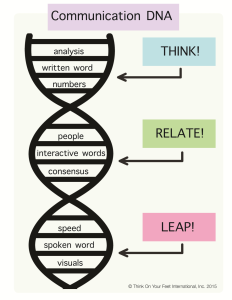Think on Your Feet International, Inc. have recently announced some interesting findings from the results of their study about how the left- and the right-side of the brain influences communication.
The brain is an amazing organ that we still need to understand. It operates your entire body, drives ambition, generates creativity, empowers critical thinking, and delivers emotions. These practical functions inspired Roger HB Davies, author of Mastering Communications, to look into how a person’s left or right brain influenced the way they communicated.
“We asked ourselves how it could be applied to the field of communications,” Davies said. “So we designed a questionnaire, asking a full range of communication-related questions.”
Without knowing, the DNA of communication was discovered.
However, to fully understand how a person communicates, we first need to understand how the brain functions. Communication is actually a fine science.
“We split the multiple choice answers (from the questionnaire) into three options: right-brained, left-brained, or can do both,” Davies explained. “When we reviewed the answers we were surprised.
“It was the middle ground, where the answers surprised us,” Davies said. “They indicated a preference for such concepts as consensus, dialogue, people, involvement, interactivity.”
Left brain responses |
The middle ground |
Right brain |
| Logic, analysis, sequence, words, spelling and the written word. | Consensus, dialogue, people, involvement, interactivity. | Visual communication – responding to images, symbols, icons and having a certain ‘speed’ in their communication. |
“In essence, they focused on the ‘people’ component of all good communications.”
Unlike traditional left vs. right brain theory, Davies discovered that communication had three buckets: analytical, visual and interactive.
“All were critical pieces needed for effective communication,” Davies said. “All valid, all useful and none better than the other.”
Davies had in fact created communication DNA; a theory of three communication styles that a person uses to relate, engage and connect more effectively.
According to his research, Davies explained that a person can have one dominating trait or combined traits of three distinct communication styles.
THINK! |
RELATE! |
LEAP! |
|
| Value structure, number sequence and logic; they prefer time to process communication. | Value relationships, consensus and flexibility; they ask questions and seek opinions from others. | Enjoy variety, change and use their time instantaneously; they thrive in high-stake, spontaneous environments. | |
Keywords |
Analysis Results Numbers Written word |
People Consensus Questions Interaction |
Speed Action Visuals Spoken word |
“We also noticed that many responses to the assessment still didn’t fit neatly into any of these buckets,” Davies said. “In brain research language, these were the communications symptoms of the double dominant.”
Basically, a person can have more than one dominating style.
Further analysis of responses and answers lead to other discoveries from Davies’ theory:
- Most had a preferred style.
- All three styles were needed for standout communication.
- Ignoring facets from one style would likely lead to misunderstanding or miscommunication.
- Personality interfered with good communications because it made it difficult to assess how someone was processing communication.
- The model also provided ‘listening’ guidelines.
- The ultimate goal was to match your counterpart’s communication style.
“Wouldn’t it be nice if everyone understood how three styles worked?” Davies asked. “If armed with this knowledge you can shift styles, when needed, to better reach your audience.”
This is the knowledge utilised to educate attendees of the Think on Your Feet® and Writing Dynamics™ programmes. They learn how to identify preferred methods of communication, how to understand the style of others and how to manage and lead more effectively.
These verbal and written communication programmes help you speed up your exchange of ideas and information. They even help to bridge generational gaps in the workplace. Most importantly, employees know how to assess, adapt and apply these traits in everyday situations.
“We’ve seen the results,” Davies said. “Parents communicate better with their children and each other; leaders reach and understand their staff; sales teams adjust their pitch to include all styles and increase their success rates; customer service teams connect better with demanding customers; and teams communicate better among themselves.” The list goes on.
Communication is fundamental to any good business. Whether you’re dealing with the public, investors, clients or your own team, the importance of getting your point across is extremely valuable. As Davies explained, the way we communicate can be traced back to simple science.
And understanding the DNA is the first step towards effective communication.
More about the workshops:
Think on Your Feet® – the complete verbal communication programme
Writing Dynamics™ – plan, draft and edit your written communications with ease!
Further resources:
Verbal communication hints and tips
Written communication hints and tips
Adapted from an original article by Ashley Denuzzo, Think on Your Feet International, Inc.
About the original authors
Roger HB Davies began his career as a journalist in the early 1970’s as one of Canada’s top business magazine editors. In 1980, he co-founded McLuhan & Davies Communications, Inc. (MDC) with Dr. Eric McLuhan, the son of media guru Dr. Marshall McLuhan.
Indigo Business Services is proud to be the European partner for MDC in Europe, teaching professionals how to think, write and speak with Clarity, Brevity and Impact® through the delivery of their leading business communication workshops.
Ashley Denuzzo comes from a wide background of media, journalism and broadcasting. A former journalist, Ashley is now the Digital Media Producer at McLuhan & Davies, Inc. She recently won a prestigious award from the RTDNA (Radio, Television, Digital News Association) for Excellence in Business Journalism and has worked in both print media and television. Ashley lives in Toronto and enjoys stand-up comedy.


